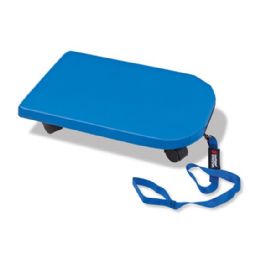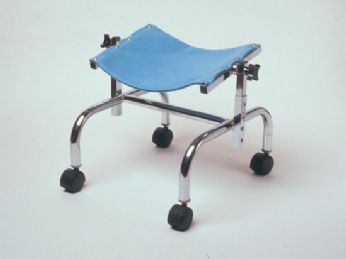




A pediatric scooter board is a versatile and effective resource to have in the home, school, clinic, or rehabilitation facility. A child or adult can sit or kneel, lay on the tummy, or lay on the back on a board. An advantage of a scooter board is improved development of upper extremity strength and to exercise the core muscles, which also improves postural support.
What are the Advantages of Sitting on a Scooter Board?
Sitting on a scooter board improves bilateral coordination since moving it requires both sides of the body to work together to propel it forward or backward. A scooter board is a great tool for strengthening both sides of the body and supporting foundational skills of bilateral coordination. It encourages both sides to work at the same time, which requires motor planning, strength, and movement fluency.
Some scooter boards are used by the therapist to sit on to make moving around easier and to reduce stress on the legs and back. Many boards have handles for balance development while sitting on them. A multi-directional scooter board can move in all directions, and may have a switch or joystick attached to drive it like an electric wheelchair. A motorized scooter board teaches a child how to move on their own. It may be activated with a switch to move ahead or in a circle to help teach cause and effect.
What are the Advantages of Laying on the Abdomen on a Scooter Board?
Laying on the tummy (prone) on a scooter board improves upper extremity strength and endurance. Shoulder stability is also a key area of focus when laying on a board since pulling with the arms requires a good amount of strength. If the activity is sustained for a period of time, it improves endurance. Postural and core strength are increased when laying on the abdomen since the abdominal, back, and neck muscles are predominantly needed for sitting in class on a mat, or at a table. These muscles are exercised by engaging in activities when laying prone on a scooter board. Also, keeping the legs straight or slightly raised from the board surface targets the core muscles.
The flow of movement on a scooter board is important when navigating it. The ability to understand the movement pattern of pulling the arms out in front, then sliding them to the side to propel forward is a complex motor plan. This movement allows a child to navigate an obstacle course easier, to tackle multiple steps in an activity, and to move faster on the board. For example, the ability to pick up a beanbag and throw it, then keep moving on the scooter board. Body awareness is knowing where an individual is in space in relation to things around them, and is an important skill for development. A child may appear ‘clumsy’ when body awareness is underdeveloped, therefore, laying prone on a board while navigating it improves this skill.
Some scooter boards have a hammock-type swing for the tummy to lay on so a child can learn to creep or belly-crawl on all fours without the coordinated movement of just the legs. Other boards are made longer to last while a child grows. Some boards have a unique shape so they do not tip, along with outside edge bumper protectors for the furniture and walls. Other scooters allow a child to lay or sit, depending on the activity. A child can begin straddling the board, then move forward to the prone position in order to develop transitional moving skills.
What are the Advantages of Laying on the Back on a Scooter Board?
Vestibular and proprioception sensory regulations make up an important part of the skills that are addressed when on a scooter board. Movements on a board, either linear or circular, target the sensations of the vestibular system and require proper processing of vestibular information. Also, further activation of the vestibular system stimulates the muscles that support balance and posture, which are essential in supporting an individual’s equilibrium. This can be best observed when laying on the back (supine) and prone.
The proprioceptive system, which is pressure through the muscles and joints, is heavily worked when undertaking scooter board tasks. To move the board, many upper limb muscles and joints are continuously being activated. This pressure, when lasting for a period of time, can provide the nervous system with a ‘calming’ sensory input to support attention and arousal. Many boards that are used for laying on the tummy can also be used to lay on the back for exercise and development.
What are the Advantages of Kneeling on a Scooter Board?
Bilateral coordination is improved when moving a scooter board while kneeling on it. This is because it requires both sides of the body to propel the board forward or backward, making it ideal for strengthening both sides of the body and supporting the basic skills of bilateral coordination. Moving the board encourages both sides to work together and at the same time, which requires motor planning, strength, and movement flow. Many scooter boards have handles so a child can maintain balance while kneeling on it. Most boards that are used for sitting can also be used for kneeling activities.
Hulet Smith, OT
Rehabmart Co-Founder & CEO
lb